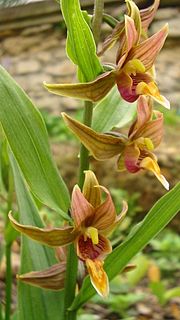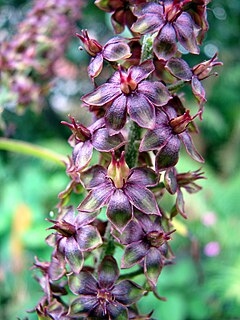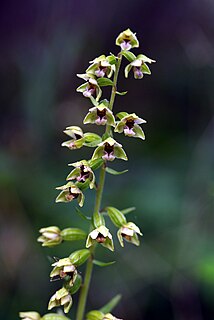False helleborine is a name is used in different parts of the world to describe several different plants of either the Orchid family or the Lily family.

The Orchidaceae are a diverse and widespread family of flowering plants, with blooms that are often colourful and fragrant, commonly known as the orchid family.

The lily family, Liliaceae, consists of about 15 genera and about 705 known species of flowering plants within the order Liliales. They are monocotyledonous, perennial, herbaceous, often bulbous geophytes. Plants in this family have evolved with a fair amount of morphological diversity despite genetic similarity. Common characteristics include large flowers with parts arranged in threes: with six colored or patterned petaloid tepals arranged in two whorls, six stamens and a superior ovary. The leaves are linear in shape, with their veins usually arranged parallel to the edges, single and arranged alternating on the stem, or in a rosette at the base. Most species are grown from bulbs, although some have rhizomes. First described in 1789, the lily family became a paraphyletic "catch-all" (wastebasket) group of petaloid monocots that did not fit into other families and included a great number of genera now included in other families and in some cases in other orders. Consequently, many sources and descriptions labelled "Liliaceae" deal with the broader sense of the family.
In the Orchid family it can refer to:

Epipactis helleborine, the broad-leaved helleborine, is a terrestrial species of orchid with a broad distribution. Its nodding flowers vary from greenish pink to purple. It prefers shaded woodland environments.

Epipactis atrorubens, the dark-red helleborine or royal helleborine, is an herbaceous plant in the orchid family, Orchidaceae.

Epipactis gigantea is a species of orchid known as the stream orchid, giant helleborine, and chatterbox. This wildflower is native to western North America from British Columbia to central Mexico. This is one of the most abundant orchids of the Pacific coast of North America.
In the Lily family it is likely to refer to either:

Veratrum album is a poisonous medicinal plant of the Liliaceae or Melanthiaceae. It is native to Europe and parts of western Asia. In Persian and Arabic, its name in traditional medicine is خربق ابیض.

Veratrum californicum is a poisonous plant native to mountain meadows at 3500 to 11,000 ft elevation in southwestern North America, the Sierra Nevada and Rocky Mountains, and as far north as Alaska and as far south as Durango. It grows 1 to 2 meters tall, with an erect, unbranched, heavily leafy stem resembling a cornstalk. It prefers quite moist soil, and can cover large areas in dense stands near streams or in wet meadows. Many inch-wide flowers cluster along the often-branched top of the stout stem; they have 6 white tepals, a green center, 6 stamens, and a 3-branched pistil. The buds are tight green spheres. The heavily veined, bright green leaves can be more than a foot long.

Veratrum nigrum is a widespread Eurasian species of perennial flower of the family Melanthiaceae. Despite its common name, V. nigrum is not closely related to the true hellebores, nor does it resemble them.









